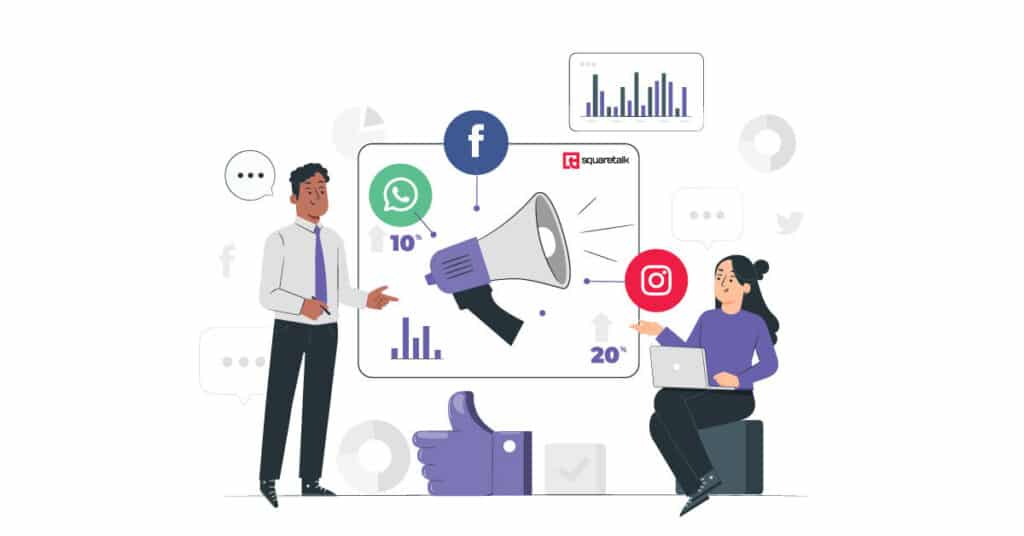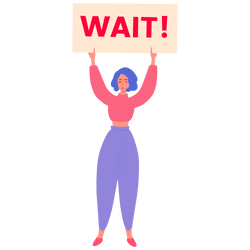With the evolving customer behaviours of the new generations we also observe the old methods losing their touch. People nowadays aren’t as responsive to cold calls or long email chains. Instead, they prefer quick, easy messaging interactions. In fact, around 60% of consumers prefer messaging over emails or phone calls.
This shift has led to the rise of omnichannel messaging, which means connecting with customers across different platforms (like chat apps, SMS, email, and more) in a seamless way.
Among these platforms, WhatsApp stands out for its widespread use and real-time connectivity. Businesses are increasingly turning to WhatsApp to engage with customers directly where they already are.
It’s not just a trend – it’s a smart strategy for boosting engagement and conversions. In fact, 68% of WhatsApp users prefer to connect with businesses via the app.
Role of WhatsApp in Sales
WhatsApp for business isn’t just another chat app. It has proven itself as a game-changer for sales outreach and customer relationship building, and here is why:
1. Real-Time Conversations for Quicker Deals
Not only can you use it as an instrument in each step of the funnel, but you can also dramatically speed up the sales process as with WhatsApp, sales reps can engage in real-time conversations that feel natural and immediate.
Unlike emails that might go unread for days, a WhatsApp message usually gets a quick glance or reply. In fact, WhatsApp messages in particular often boast an open rate near 98% – dramatically higher than email.
This speed allows reps to address questions or objections on the spot. A fast back-and-forth chat can nurture a lead and move them closer to purchase and it often does this much faster than an email thread could.
2. Personal Connection for Better Conversion Rates
And what is more important than creating that personal connection for closing a deal? Nothing!
Messaging through an app on the customer’s own phone makes the interaction feel direct and friendly. Sales reps can use WhatsApp to greet clients by name and use a warm tone, making customers feel valued.
This informal channel humanizes the sales process. Customers feel like they have a personal contact, not just a generic salesperson. That rapport can increase trust and the likelihood of a sale.
Businesses adopting WhatsApp in sales outreach have reported significant uplifts – for example, a 27% increase in sales conversions in one case.
3. Rich Communication Features for Better Sales Arguments
Not being limited to text brings the opportunities for landing that sale to another level. With WhatsApp sales agents can share product photos, demo videos, PDFs of brochures, or even voice messages.
For example, a rep might send a quick video demo of a product in action. They could also share a picture of a recommended item.
These media features help customers experience the product virtually and can answer questions in a visual way. Rich content makes the conversation more engaging and persuasive than text alone.
4. Global Reach and Ubiquity for Smooth Outreach
And last, but not least – WhatsApp’s global reach is unmatched, with over 2 billion active users worldwide.
Most of your customers already use WhatsApp, so your sales team can reach prospects on a platform they’re comfortable with. This ubiquity means less friction – you’re communicating through an app they trust and check regularly.
Key Features of WhatsApp that Aid Sales
WhatsApp (especially via WhatsApp Business) offers several features that can assist sales teams to streamline communication and better manage customer interactions. Before diving into these features, it’s important to understand the differences between WhatsApp, WhatsApp Business, and WhatsApp Business API to choose the right option for your business needs:
- Business Profile & Catalog : WhatsApp Business lets you set up a company profile and even showcase products in a catalog (with pictures, descriptions, and prices). Customers can browse these offerings right in the chat, so you can share product info without them ever leaving the conversation.
- Quick Replies & Templates : Use Quick Replies to save and reuse answers to common questions, so you don’t have to type the same reply repeatedly. With the WhatsApp Business API, you can also send pre-approved message templates (for things like order confirmations or appointment reminders) to customers quickly and consistently.
- Labels for Organization : Organize your chats with labels (e.g., “New Lead,” “Pending Payment,” “Closed Deal”). Labels let you easily filter conversations by stage or priority, ensuring you follow up with everyone appropriately and nothing falls through the cracks.
- Broadcast Lists & Group Chats : Use Broadcast Lists to send the same message to many contacts at once – great for promotions or announcements (each recipient sees it as a private message). Group chats can be used to involve multiple people (e.g., a rep, a manager, and the client) in one conversation for complex deals, but use groups sparingly to avoid overwhelming the customer.
- Read Receipts and Status : WhatsApp’s check marks show when a message is sent, delivered, and read. These read receipts tell you if a prospect saw your message, which helps you time your follow-ups (if it’s read but no reply, you know to send a gentle reminder).
Best Practices for Using WhatsApp in Sales
To use WhatsApp effectively in sales, teams should follow some best practices. These guidelines ensure you maintain professionalism and make the most of the platform :
1. Personalize Communication
Address customers by name and reference their specific interests or past interactions. This personal touch shows you value them as individuals, building trust and making them more receptive to your message.
2. Conversational Yet Professional
Use a friendly, conversational tone – this isn’t a formal email. At the same time, keep it professional in wording and respect. Aim for a human, approachable voice that reflects your brand (warm and helpful, but still courteous and clear).
3. Be Timely and Responsive
Respond quickly on WhatsApp 90% of consumers say an immediate response is important. Even if you don’t have a full answer yet, send a quick acknowledgment to let the customer know you’re on it. Prompt responses show reliability and keep the momentum going.
4. Use Rich Media Wisely
Share images, videos, or documents to enhance your communication, but use them judiciously. A well-chosen photo or a short demo video can boost interest and clarity. Just avoid overwhelming customers with too many files or very large attachments, especially if they didn’t request them.
5. Set Boundaries
Establish reasonable expectations with customers. Let them know your business hours or response times (you can use an away message after hours). This sets boundaries so they aren’t upset if you reply the next morning. Also, keep the conversation focused – it’s fine to be friendly, but stay on topic and respect the customer’s time.
6. Track and Follow Up
Stay organized by using labels or a contact center platform to track each conversation’s status and set reminders. For example, if a prospect says they’ll decide next week, note that and follow up via WhatsApp at the agreed time. Pay attention to read receipts – if your message was seen but not answered, a polite follow-up can nudge them. By tracking chats and following up diligently, you ensure hot leads don’t go cold.
Implementation Steps for Businesses
Ready to empower your sales team with WhatsApp? Here are key steps to implement WhatsApp as part of your sales strategy :
1. Train Your Sales Team
Educate your sales staff on using WhatsApp effectively. Make sure everyone understands to obtain customer consent before messaging and to respect any opt-out requests.
2. Integrate with Systems
Connect WhatsApp with your CRM or sales contact center software, if possible. Using the WhatsApp API or an integration tool, ensure chats are logged in your CRM and visible to the team.
Integration makes sure no customer inquiry slips through unnoticed and allows team collaboration on answering questions.
3. Develop a Messaging Strategy
Plan how WhatsApp will be used in your sales process. Decide when to use WhatsApp (e.g. for quick follow-ups, sharing quotes, scheduling demos) versus other channels like email or calls and how to combine them effectively.
Prepare a few template messages for common situations to maintain consistency. Also set guidelines on message frequency so prospects find your outreach helpful, not spammy.
4. Pilot and Gather Feedback
Test WhatsApp with a small pilot program. Have a few reps use it with a sample of customers for a trial period. Track the results (response times, engagement, conversion rates) and gather customer feedback.
Learn from the pilot – you might refine your message templates or timing based on what worked best – before rolling out to the whole team.
5. Scale and Optimize
Roll out WhatsApp to your broader sales team and keep monitoring performance. Watch metrics like response rate and conversion rate to gauge success. Continually optimize your approach : for instance, if you find customers respond more in the evening, adjust your outreach timing.
Stay updated on new WhatsApp features or best practices, and train your team accordingly. By treating WhatsApp as an evolving part of your sales strategy, you’ll maximize its effectiveness over time.
Future Trends in Omnichannel Sales with WhatsApp
The way businesses use WhatsApp for sales will continue to evolve. Here are some future trends to watch :
- AI-Powered Chatbots : Expect AI-powered features to chat with customers in WhatsApp. More initial interactions may be handled by AI chatbots that answer FAQs or collect basic info before handing off to a human. This gives customers instant 24/7 answers and frees up sales reps to focus on high-value leads who need a personal touch.
- Conversational Commerce : WhatsApp is moving toward conversational commerce – enabling customers to browse products and complete purchases via chat. Features like in-app payments and shopping carts are emerging. Before long, a customer might go from inquiry to checkout entirely within a WhatsApp conversation, making the buying process seamless.
- Deeper Channel Integration : Channels will become even more interconnected. Soon, a conversation might move effortlessly from a website chat to WhatsApp to another platform without losing any context. Sales teams will use unified inboxes or dashboards to manage these multi-channel conversations as one thread. No matter how a customer contacts you, the experience will feel continuous and consistent.
- Enhanced Analytics : Analytics for messaging will get more sophisticated. Businesses will gain better insight into WhatsApp engagement – for example, tracking which messages or approaches lead to the most conversions, or analyzing customer sentiment in chats. This will help sales teams refine their tactics and achieve even better results.
- Cross-Platform Campaigns : Marketing and sales efforts will intertwine closely on messaging apps. For instance, a customer might click a social media ad or an email link and instantly launch a WhatsApp chat with a sales rep. Companies will integrate WhatsApp into broader campaigns so that customers get timely, relevant outreach on their preferred channel, and sales reps receive warm leads directly in their WhatsApp inbox.
Conclusion
In today’s sales landscape, WhatsApp has emerged as a powerful tool for driving conversions. Using WhatsApp as part of an omnichannel strategy lets you meet prospects on their terms.
It provides a seamless experience that keeps them engaged. It’s not just convenient – it leads to tangible results like higher response rates, better customer satisfaction, and ultimately more sales.
Sales will always be about relationships and trust, and WhatsApp adds a personal touch to strengthen those bonds – keeping a sales rep just a message away whenever a customer has a question. As trends like AI chatbots and conversational commerce grow, WhatsApp is set to play an even bigger role in connecting businesses with buyers.
The takeaway for businesses is clear: it’s time to adapt and embrace messaging in sales. Equip your team with WhatsApp and an omnichannel mindset to stay ahead of the curve. Don’t get left behind – start incorporating WhatsApp into your sales strategy today and watch your conversions soar. Meet your customers where they are and turn those conversations into closed deals.
FAQ
How can WhatsApp be used effectively by sales teams to boost conversions?
A: WhatsApp enables real-time conversations with a 98% open rate, speeding up deals. Personal connections increase conversion rates by 27%. Features like sharing photos, videos, and PDFs enhance engagement. Best practices include personalizing messages, responding quickly, using rich media wisely, setting boundaries, and tracking progress.
What are the benefits of integrating WhatsApp into an omnichannel messaging strategy?
A: Integrating WhatsApp provides a seamless customer experience across channels, leading to higher response rates and satisfaction. It strengthens relationships and trust, keeping sales reps accessible. Future trends include AI chatbots and in-app payments for enhanced commerce.
Is it possible to track and measure sales performance through WhatsApp conversations?
A: Yes, sales performance can be tracked using labels (e.g., New Lead,””Closed Deal”), read receipts, and CRM integration. Metrics like response and conversion rates help optimize strategies.
How secure is WhatsApp communication for customer interactions?
A: WhatsApp’s global use by over 2 billion users suggests secure interactions, supported by business features like profiles and catalogs. Messages stay end-to-end encrypted on both the WhatsApp Business App and the API, and Facebook cannot read the content.
Can WhatsApp be integrated with CRM systems and other sales tools?
A: Yes, WhatsApp integrates with CRMs via its API, logging chats for team visibility, enhancing collaboration, and preventing missed inquiries.








